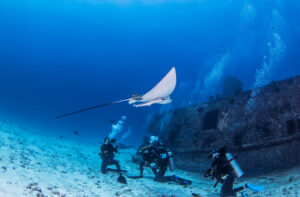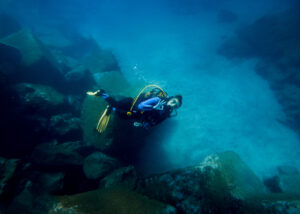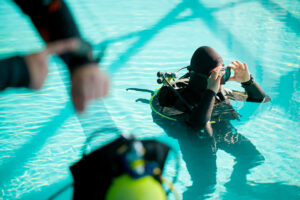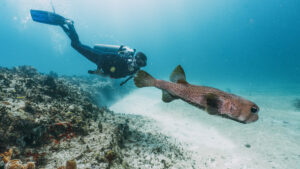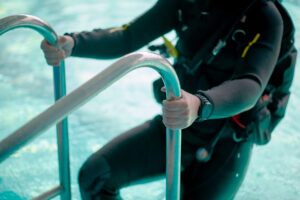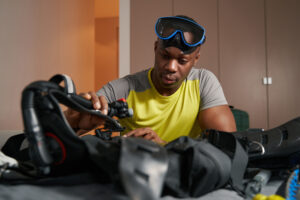What is a Lost Buddy Drill?
The lost buddy drill is a critical safety procedure in scuba diving designed to locate a missing dive partner and ensure the safety of both divers. When a buddy pair becomes separated underwater, it is vital to act quickly and effectively to minimize risk. This drill outlines a series of steps to be taken in such an event, focusing on maintaining calm, executing a systematic search, and communicating effectively. The lost buddy drill is an essential part of scuba training and is emphasized for all levels of divers, from beginners to advanced technical divers, due to its potential to prevent accidents and save lives.
Historical Context
The origins of the lost buddy drill can be traced back to the early days of recreational diving when safety protocols were still in their infancy. Initially, diving was a relatively unregulated activity, and safety procedures were developed through experience and necessity rather than formal training. As the popularity of scuba diving grew in the mid-20th century, so did the need for standardized safety measures. Early diving manuals began to include basic buddy system principles, emphasizing the importance of staying close to one’s partner.
Over time, the diving community recognized the need for more structured safety protocols. Notable incidents, such as high-profile diving accidents, highlighted the risks associated with losing a buddy underwater. These events prompted diving organizations to formalize the lost buddy drill as a standard procedure in training programs. The drill has since evolved, incorporating advances in technology and diving practices to enhance its effectiveness. Today, it remains a cornerstone of scuba safety, underscoring the importance of preparedness and proper training.
Purpose and Importance
The primary purpose of the lost buddy drill is to ensure the safety of divers by providing a clear and structured response to losing a dive partner. This procedure helps reduce panic, allowing divers to think clearly and act methodically. In the potentially hazardous environment of underwater exploration, staying calm and executing a planned response can be the difference between a safe resolution and a dangerous situation.
The lost buddy drill is crucial in various diving environments, from recreational to technical diving. Recreational divers often operate in relatively benign conditions, but even in these scenarios, losing a buddy can quickly escalate into a serious issue. Technical divers, who venture into more challenging and hazardous environments, rely even more heavily on such drills. The complexity and potential dangers of their dives make the lost buddy drill an indispensable part of their safety protocols.
Moreover, the drill fosters a culture of responsibility and mutual care among divers. It reinforces the buddy system, a fundamental aspect of scuba diving, where divers are responsible for each other’s safety. By practicing the lost buddy drill, divers internalize the steps needed to protect themselves and their partners, enhancing overall safety in the diving community.
Steps of the Lost Buddy Drill
Executing the lost buddy drill involves several detailed steps designed to maximize the chances of reuniting with a lost buddy while ensuring the safety of both divers. The first step is the initial recognition of the situation. If a diver notices that their buddy is missing, they must immediately stop and take a moment to assess their surroundings and recall the last known location of their partner. This pause helps prevent impulsive actions that could lead to further separation.
The next step involves a systematic 360-degree search. The diver should slowly turn in place, visually scanning the area while looking for bubbles, light signals, or any sign of their buddy. This search should last no more than one minute to avoid wasting valuable time and air. During this time, divers should also check their gauges to ensure they have enough air to continue the search or ascend safely.
If the initial search does not locate the buddy, the diver should use their dive equipment to aid the search. Signaling devices like underwater noisemakers or torches can attract the lost buddy’s attention. Deploying a surface marker buoy (SMB) can help indicate the diver’s position to surface support, such as a dive boat or shore-based lookout, which may assist in locating the lost diver.
Following these immediate actions, the diver should ascend to a predetermined depth, usually halfway between the current depth and the surface, while continuing to search. If the buddy is still not found, the diver should proceed to the surface at a controlled rate, ensuring they follow proper decompression procedures if necessary. Once on the surface, the diver should signal for help using standardized distress signals and begin a surface search for their buddy.
Throughout the drill, maintaining calm and control is paramount. Panic can impair judgment and lead to poor decision-making, increasing the risk of injury or further separation. Divers are trained to stay composed and follow the steps methodically, ensuring the best possible outcome in a stressful situation.
Equipment Used in Lost Buddy Drill
Several pieces of equipment play a vital role in the effective execution of a lost buddy drill. The dive computer is perhaps the most crucial, providing real-time information on depth, time, and decompression status. By monitoring this data, divers can make informed decisions during the search and ascent, ensuring they remain within safe limits.
Signaling devices are also essential. Underwater noisemakers, such as tank bangers or shakers, can produce sounds that carry well underwater, attracting the attention of the lost buddy. Visual signals, like dive torches, are particularly useful in low-visibility conditions or during night dives. A well-aimed beam of light can be seen from a considerable distance, aiding in the search.
Navigation tools like compasses and underwater maps help divers maintain their orientation and conduct a systematic search. Knowing the dive site’s layout can provide clues about where the lost buddy might have gone. Additionally, surface marker buoys (SMBs) are indispensable for signaling surface support. An SMB can mark the diver’s position, making it easier for boats or rescue teams to assist in the search.
Communication tools, such as underwater slates and hand signals, are also integral to the lost buddy drill. These allow divers to convey important information quickly and effectively, even in the absence of direct visual contact. Clear communication helps coordinate the search and ensures that both divers are aware of each other’s actions and intentions.
Training and Practice
Regular training is essential for the effective execution of the lost buddy drill. Divers are encouraged to practice the drill frequently to internalize the steps and build confidence. Training typically begins in controlled environments, such as swimming pools, where divers can focus on mastering the procedure without the added stress of open water conditions.
Pool sessions allow divers to practice key elements of the drill, such as the 360-degree search and the use of signaling devices, in a safe and controlled setting. These sessions are often conducted under the supervision of experienced instructors who can provide guidance and feedback. Repetition in this environment helps reinforce the correct procedures and build muscle memory.
Once divers are comfortable with the drill in a pool, they can practice in open water. Open water practice introduces additional variables, such as varying visibility, currents, and other environmental factors. This practice is crucial for preparing divers to perform the drill effectively in real-world conditions. During open water sessions, divers often simulate various scenarios, such as losing a buddy in low visibility or dealing with equipment malfunctions, to ensure they are prepared for a range of situations.
Dive instructors play a critical role in training. They provide instruction on the proper execution of the drill, demonstrate techniques, and offer constructive feedback. Instructors also help divers develop problem-solving skills and the ability to remain calm under pressure, which are essential for successful execution of the lost buddy drill.
Variations and Adaptations
The lost buddy drill can be adapted to suit different diving conditions and environments. In clear water with good visibility, the standard 360-degree search may be sufficient to locate a lost buddy. However, in low-visibility conditions, divers may need to rely more heavily on signaling devices and tactile communication. For example, using a dive torch to sweep the area can help locate a buddy in murky water.
Different diving disciplines also require adaptations to the lost buddy drill. Technical divers, who often operate in deep or hazardous environments, may have additional steps in their drill to account for the complexity of their dives. This can include using redundant air supplies, employing advanced navigation techniques, and coordinating with a larger dive team. These adaptations ensure that the drill remains effective in more challenging scenarios.
Night diving presents unique challenges that require specific adaptations. During night dives, visual signals are paramount, and divers must be proficient in using dive torches and glow sticks. The search pattern may also need to be adjusted to account for the reduced visibility. Divers should be trained to handle the psychological aspects of night diving, such as reduced sensory input and increased reliance on equipment.
Solo divers, although less common, also need to adapt the lost buddy drill for their specific situation. Solo divers must be self-reliant and have a comprehensive understanding of their equipment and emergency procedures. While the concept of a lost buddy does not directly apply, solo divers must be prepared to handle any emergency independently, including equipment failure or disorientation.
Common Mistakes and How to Avoid Them
Several common mistakes can undermine the effectiveness of the lost buddy drill, but awareness and training can help divers avoid these pitfalls. One of the most frequent errors is panic. Panic can cause divers to act irrationally, leading to hasty decisions and further separation. To avoid panic, divers should practice stress management techniques and focus on maintaining a calm and methodical approach during the drill.
Another common mistake is neglecting equipment checks. Regularly inspecting and maintaining dive gear is crucial to ensure all equipment functions correctly when needed. Divers should familiarize themselves with the operation of their signaling devices, dive computers, and other essential equipment. Performing pre-dive checks and practicing with the equipment can help prevent malfunctions during the drill.
Ineffective search patterns can also hinder the success of the lost buddy drill. Divers should practice the 360-degree search regularly to ensure they execute it correctly and thoroughly. This practice includes maintaining a controlled rate of rotation and being vigilant for any signs of the lost buddy. Divers should also be aware of the limitations of the search and be prepared to move on to the next step if the initial search is unsuccessful.
Poor communication with
dive buddies is another issue that can arise. Clear and consistent communication is essential throughout the dive, not just during the drill. Divers should agree on hand signals, dive plans, and emergency procedures before entering the water. Regularly practicing communication techniques can help ensure both divers understand each other during an emergency.
Case Studies and Real-life Examples
Analyzing real-life incidents involving lost buddy drills provides valuable insights into the effectiveness of the procedure and highlights lessons learned. One notable case involved two recreational divers who became separated during a dive in moderate visibility. The divers had practiced the lost buddy drill extensively and executed it flawlessly. The diver who realized the separation conducted a thorough 360-degree search, used a signaling device to attract attention, and ascended to the predetermined depth. The lost buddy, noticing the signals, quickly rejoined the diver. This incident underscored the importance of regular practice and effective use of equipment.
Another case involved a technical diving team operating in a challenging cave environment. During the dive, one member became separated due to a navigational error. The team immediately implemented their lost buddy drill, which included using line markers and specialized communication devices. The search was successful, and the lost diver was located quickly and safely. This case highlighted the need for advanced adaptations of the drill in technical diving scenarios and the effectiveness of thorough training and preparation.
A more tragic incident involved a solo diver who failed to return after a routine dive. The subsequent investigation revealed that the diver had not adequately prepared for emergency scenarios and lacked proper equipment. This case emphasized the importance of self-reliance for solo divers and the critical need for comprehensive training and preparation, even when diving alone.
Key Takeaways
The lost buddy drill is an essential safety procedure in scuba diving, designed to locate a missing dive partner and ensure the safety of both divers. Its importance cannot be overstated, as it helps prevent accidents and save lives. Regular training, effective use of equipment, clear communication, and adaptations for various diving conditions are all crucial components of a successful lost buddy drill. By practicing this drill and internalizing its steps, divers can enhance their safety and preparedness, contributing to a safer and more enjoyable diving experience for all.




